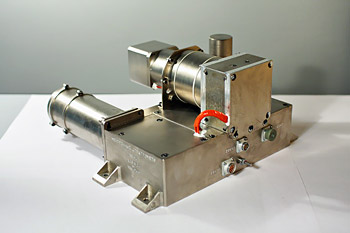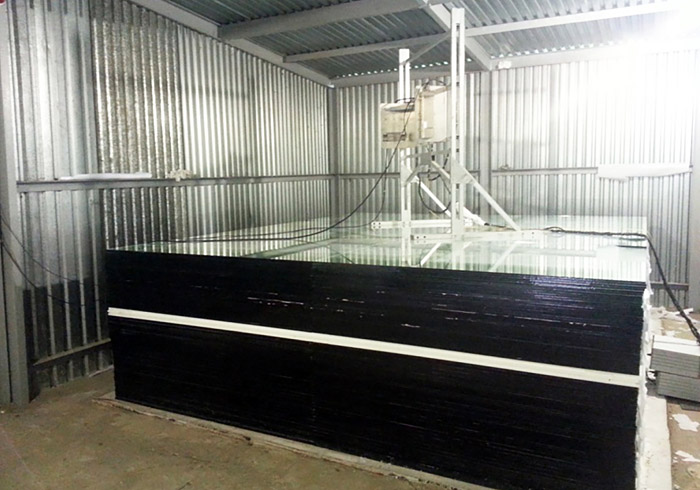
Electronic english version since 2022 |
The newspaper was founded in November 1957
| |
Space research at the Laboratory of Radiation Biology
Multifaceted work related to the space theme is carried out at LRB JINR. Among activities, in addition to space radiobiology, aimed at studying the biological effects of the action of heavy charged particles on biological objects of different levels of organization, there are joint investigations with Italy of the formation of complex prebiotic compounds when irradiated with formamide cosmic radiation with meteorites as a catalyst, as well as biogeochemical research of space matter (bacterial paleontology in astromaterials), headed by Academician of the Russian Academy of Sciences A.Yu.Rozanov. The establisher and Scientific Leader of LRB, Corresponding Member of the Russian Academy of Sciences E.A.Krasavin has spoken about this subject in detail more than once on the pages of the newspaper.
However, LRB's involvement in space research is not limited to this. Another aspect of the participation of the Laboratory in space affairs is determined by the close cooperation of LRB and FLNP specialists (headed by V.N.Shvetsov and G.N.Timoshenko) with the Space Research Institute (IKI) in the field of nuclear planetology that has been going on for more than 25 years. Nuclear planetology is a young field of science related to the use of nuclear physics methods to study the elemental composition of the surfaces of celestial bodies from orbit or ground. The Department of Nuclear Planetology was established at IKI in 2014 headed by Igor Grigorievich Mitrofanov, who was the first to propose this new term. Corresponding Member of the USSR Academy of Sciences I.S.Shklovsky and Academician of the Russian Academy of Sciences R.Z.Sagdeev were involved in the emergence of a new research area.
As the previous Director of IKI Academician L.M.Zeleny recalls the difficult 1990s, "experimenters of our Institute paved the way to foreign (European and American) spacecraft at the cost of great and constant efforts. The first was Doctor of Physical and Mathematical Sciences I.G.Mitrofanov with the HEND (High Energy Neutron Detector) device on the NASA Mars Odyssey spacecraft (launched in 2001)." The history of cooperation between the Department of Planetology of IKI and JINR started in 1997 in the process of developing this neutron spectrometer that was intended for mapping from orbit the spectral density of the albedo neutron flux from the surface of Mars to evaluate the mass fraction of water ice and chemically bound water in the near-surface soil layer. Subsequently, many Russian experiments were implemented on NASA and European Space Agency spacecraft on the basis of intergovernmental agreements between Roscosmos and these organisations.
 LRB participated in the development, research of characteristics, testing and calibration of neutron detectors and gamma ray spectrometers for missions to the Moon, Mars and Mercury: 2001 Mars Odyssey (HEND, pictured), LRO (LEND), Phobos-Grunt (HEND Phobos) , MSL (DAN), ISS (BTN-Neutron), ExoMars Trace Gas Orbiter (FREND), ExoMars (ADRON-RM), BepiColombo (MGNS) and Luna-26 (LGNS-GD). Important results were obtained with these instruments: such as, the HEND neutron spectrometer confirmed that there are huge reserves of subsurface water ice near the poles of Mars and even in middle latitudes and using the LEND instrument, water ice was discovered inside craters at the south pole of the Moon.
LRB participated in the development, research of characteristics, testing and calibration of neutron detectors and gamma ray spectrometers for missions to the Moon, Mars and Mercury: 2001 Mars Odyssey (HEND, pictured), LRO (LEND), Phobos-Grunt (HEND Phobos) , MSL (DAN), ISS (BTN-Neutron), ExoMars Trace Gas Orbiter (FREND), ExoMars (ADRON-RM), BepiColombo (MGNS) and Luna-26 (LGNS-GD). Important results were obtained with these instruments: such as, the HEND neutron spectrometer confirmed that there are huge reserves of subsurface water ice near the poles of Mars and even in middle latitudes and using the LEND instrument, water ice was discovered inside craters at the south pole of the Moon.
To test instruments for nuclear planetology using neutron generators, a special testing bench with a sample of planetary soil was created at LRB. In order to reduce the background of scattered neutrons, the bench is positioned in a light hangar equipped with a blocking and signaling system to ensure radiation safety. On it, in particular, the DAN device was tested as part of the Curiosity rover to measure the water content in the soil along the vehicle's route (lower image).

To estimate the radiation risk of cosmonauts during long-term interplanetary flights, a set of computational works was carried out in LRB. Up-to-date, on the basis of programs for the transport of radiation in matter using the Monte Carlo method, detailed calculations of the characteristics of all components of the radiation field inside the habitation module of a spacecraft in deep space at the minimum and maximum solar activity were carried out. As a model of Galactic Cosmic Radiation (GCR), a semi-empirical algorithm was used based on the experimental data of the NASA CRIS spectrometer on the ACE apparatus near the Lagrange point 1 at a distance of about 1.5 million km from the Earth. The spectra of GCR particles were set in the energy range from 10 to 105 MeV/n. With its completeness and accuracy the carried out calculation differs favorably from similar NASA calculations using their HZETRN program based on the analytical solution of the linear Boltzmann equation. The LRB calculations of such a large volume within a reasonable time turned out to be possible only through the use of the heterogeneous HybriLIT LIT platform. The calculation results showed that even a relatively small thickness of the ship's shell (15 g/cm2 of aluminum) noticeably changes the characteristics of the internal radiation field: unstable particles (neutrons and mesons), nuclei and gamma quanta appear in large amounts and the overall particle fluence even increases.
The efficient dose is an overly conservative estimate of the radiation risk of astronauts due to the fact that it does not take into account either the gender or age characteristics of crews. Further, the damaging ability of cosmic radiation, especially heavy nuclei, strongly depends on their energy that entails the need to correctly take into account the dependence of the quality factor of each specific type of radiation on LET (linear energy transfer) as a function of its energy. All this prompted LRB to develop a special approach to estimating the radiation risk of cosmonauts representing a narrow cohort of non-smokers and healthy men aged 30-60 years, as well as to calculate the fluence conversion coefficients - the efficient dose for all components of cosmic radiation depending on the radiation energy.
Based on the calculated spectra of the particles of the radiation field inside the spaceship and the new fluence - effective dose coefficients, a realistic estimate of the effective dose rate of astronauts in deep space at the minimum and maximum of solar activity was carried out. It is shown that the total risk of astronauts for the entire Martian mission in the most probable NASA Long-Stay Mission scenario will correspond to the risk value regulated by NASA of 3%, that is, the real effective dose of astronauts per mission will not exceed 1 Sv. The results of the work were published in a number of leading foreign journals.
The obtained calculated spectra of the components of the internal radiation field in the spaceship allowed to start developing a facility for simulating cosmic radiation under terrestrial conditions for the purposes of space radiobiology. The fact is that in space, irradiation is carried out simultaneously by all components of the field of all possible energies, while ground-based experiments are carried out on monobeams of accelerators with a fixed energy, as a result of which, under terrestrial conditions, it is not possible to reproduce adequate conditions for space irradiation. So far, this crucial problem has not been solved, although since 2016 at NASA in Brookhaven, attempts have been made to simulate GCR using uperposition of successive irradiation of samples with a large number of beams of protons and alpha particles of various energies.
In LRB, a method was proposed to form a radiation field behind the simulator, irradiated by a beam of 56Fe nuclei with energy of 1 GeV/n, close to the radiation field inside a spaceship in deep space. A patent has been filed for this method. The simulator uses sets of sectoral targets of various thicknesses to produce various fragments of the projectile. The energy of the projectile nucleus and its atomic weight are sufficient to actually completely simulate all the main biological effects in samples from cosmic radiation during irradiation behind the simulator. The simulator generates a uniform field of fragments of the projectile nucleus behind the simulator with a charge distribution of fragments and a total LET distribution close to the experimental ones (measured using the RAD and Liulin-MO instruments on the Earth-Mars flight path of the Mars Science Laboratory (Curiosity) missions in 2012 and the detector Liulin-MO of the ExoMars Trace Gas Orbiter mission, 2016). The fundamental difference between the LRB simulator and the NASA simulator is the adequacy of space simultaneous irradiation using all particles in the entire energy spectrum. The simulator is proposed to be placed on a specialized heavy-ion radiobiological channel of LRB that is developed at the Nuclotron within the framework of the NICA innovation program.
In 2021, the series of works "Calculation and simulation of the radiation field inside a spacecraft outside the Earth's magnetosphere", implemented in 2017-2021 by G.N.Timoshenko and I.S.Gordeev, was awarded the first JINR prize in the section "Scientific and technical applied work ".
Gennady TIMOSHENKO,
Assistant Director of LRB in Radiation Physics